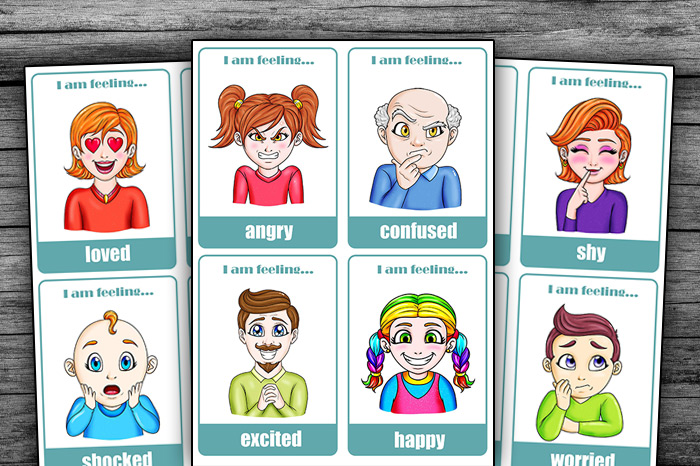Young children and toddlers can struggle to recognise and understand their feelings and the emotions of others around them. It can be confusing and frustrating for kids and parents, alike in the early years.
If you want to help your children learn about the emotions they are feeling these emotion flashcards could be perfect for you. Teach them the vocabulary they need to explain how all the different emotions they are feeling.



We’ve made a few suggestions below on how you can use these free emotion cards.
Who Can Use The Emotions Flashcards?
These free printables are perfect for children learning about feelings and emotions. Encourages language development, communication and conversation.
They are also a great tool to use with older children, who may be on the autistic spectrum (ASD) and may struggle to understand what others are feeling or find it hard to say how they feel.
Non-verbal children could use them to communicate feelings and emotions.
They’re great for anyone who needs a little help understanding the different facial expressions they might see around them.
What’s Included
- The beautifully illustrated feelings flashcards, which are downloadable, free and printable show a picture of someone expressing a different emotion.
- There are 12 emotional flashcards on 3 pages. Each flashcard features an image and text.
- They have “I am feeling” written at the top of the card.
- The image shows a person’s head, shoulders and arms. Each person has a demeanour that demonstrates their feeling. The images are humorous – the funny styles will appeal to young learners.
- At the bottom of each flashcard, the feeling is stated in white bold on a green background.
- The flashcards have illustrations showing angry, confused, excited, happy, loved, sad, shocked, surprised, tired, shy, upset and worried.
Emotions Flashcard Sizes
The emotional flashcards are large. Each card is intended to be at 1/4 A4 size.
For smaller sizes you can use the settings on your printer to print all 3 pages on one piece of paper so you have smaller cards.
If you want them bigger, if you have a scale option you will be able to print one flashcard per A4 page – these will be perfect to make a feelings poster for preschool or toddlers to look at. If you are looking for a free printable emotions poster we have one here.
How Can I Use these Emotions Flashcards?
These emotion flashcards for children are helpful, as they teach kids how to label their emotions. It will build their emotional intelligence. It will help them communicate better how they are feeling. They will learn to recognise and control their emotions. They will learn the words to describe how they feel.
There is a range of activities, games as well as arts and crafts you can use these cards for.
We’ve listed a few ideas below to get you started.
Pick a Card – Great for Toddlers
Who doesn’t love to pick a card from a set of cards spread out like a fan? Spread out the printed emotion flashcards in a fan.
Let your child pick the card and ask them to tell you what the person is feeling. If they don’t know tell them and let them pick another. Keep going until they get bored. Come back to it another day.
If your child is a little older, you ask them to read what the emotion is and ask them how they would look if they felt like that. Ask them what might make them feel like the emotion displayed.
Play a Feelings Memory Matching Game
Print out 2 of each emotion. Perhaps print them a bit smaller for this game.
Cut the flashcards out and lay them face down on the table in rows.
Pick a player to go first – maybe the youngest player.
Each person when it’s there go turns over any two cards (one at a time). If the cards match they get to keep them and have another go.
If they don’t match they get turned back over, so they are face down and the next person has a turn.
The person who collects the most pairs of emotions is the winner.
Emotions – Hide Your Mouth
This is a really fun game for toddlers and preschoolers. Print out the feeling face cards, in turn, you pick an emotion card. You then put your hand over your mouth and make the emotion shown on your card.
The other people have to try and guess what the emotion is without being able to see the mouth. They need to look at the eyes and other facial features to figure out what emotion is being acted out.
How Are You Feeling Today Chart
Print out lots of small emotion flashcards and cut them up.
Get some cardboard and draw a 7 x 2 grid. Write the days of the week in one row. Each day ask your child to stick the feeling face card of their choice under the day of the week.
You could repeat this for one week or several weeks and track what mood they are in each day.
Conclusion
There are so many ways that you can use these free printable emotion flashcards. Whether you want to put on a puppet show, play the matching memory game or make a feelings chart it will be a great way to help your child learn about feelings.
For the younger children simply use the flashcards to show your toddler what a feeling looks like or use them as prompts so you can discuss it will enable their emotional literacy.



